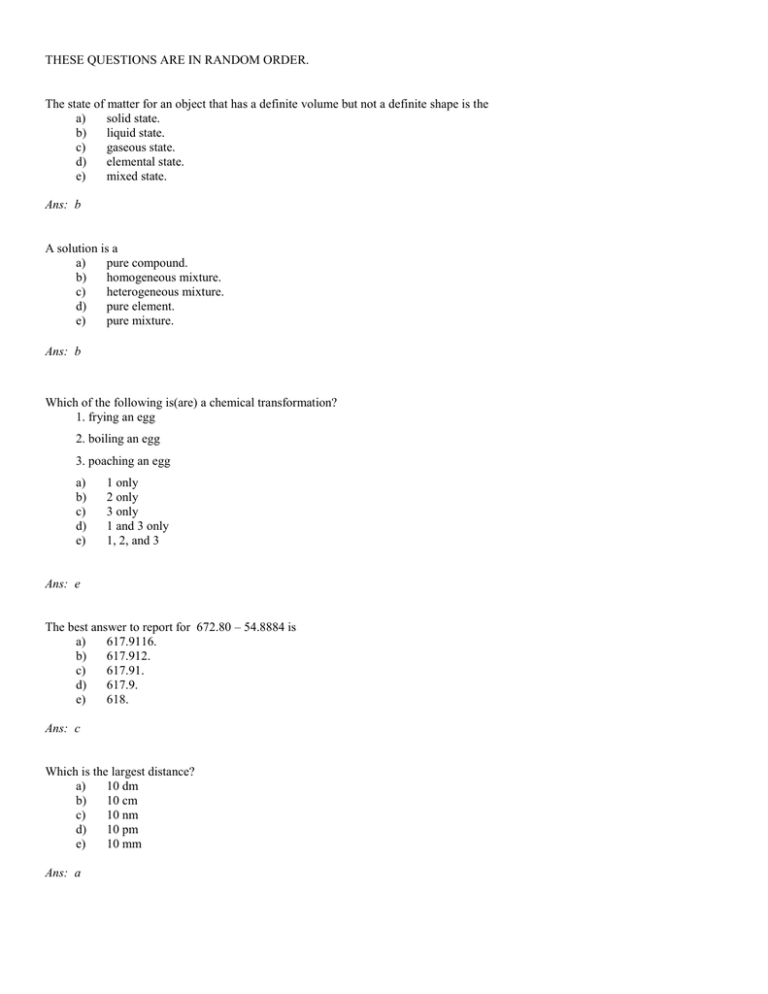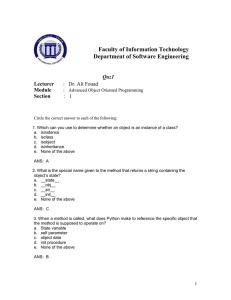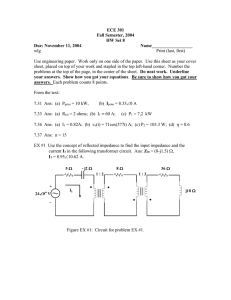THESE QUESTIONS ARE IN RANDOM ORDER.
advertisement

THESE QUESTIONS ARE IN RANDOM ORDER. The state of matter for an object that has a definite volume but not a definite shape is the a) solid state. b) liquid state. c) gaseous state. d) elemental state. e) mixed state. Ans: b A solution is a a) pure compound. b) homogeneous mixture. c) heterogeneous mixture. d) pure element. e) pure mixture. Ans: b Which of the following is(are) a chemical transformation? 1. frying an egg 2. boiling an egg 3. poaching an egg a) b) c) d) e) 1 only 2 only 3 only 1 and 3 only 1, 2, and 3 Ans: e The best answer to report for 672.80 – 54.8884 is a) 617.9116. b) 617.912. c) 617.91. d) 617.9. e) 618. Ans: c Which is the largest distance? a) 10 dm b) 10 cm c) 10 nm d) 10 pm e) 10 mm Ans: a The melting point and the normal boiling point of water can be used to calibrate thermometers. What are these respective temperatures in kelvins? a) 32 and 212 b) 0 and 100 c) 100 and 273 d) 0 and 373 e) 273 and 373 Ans: e Calculate the mass of aluminum that occupies the same volume as 66.7 g of cobalt. The density of cobalt is 8.90 g/cm 3 and the density of aluminum is 2.71 g/cm3. a) 2.77 g b) 20.3 g c) 1.61 × 103 g d) 0.362 g e) 0.00457 g Ans: b Four cubes of equal mass are made of lead (density = 11.3 g/cm3), silver (10.5 g/cm3), iron (7.90 g/cm3), and aluminum (2.70 g/cm3). Which cube has the longest edge? a) lead b) silver c) iron d) aluminum e) all four cubes have the same length edge Ans: d A car averages 30.0 miles per gallon of gasoline. How many liters of gasoline will be needed for a trip of 565 km? Some conversion factors that may be helpful are the following: 1 qt = 0.946 L 1 mile = 1.609 km 4 qt = 1 gal (exactly) 1 ft = 12 in (exactly) a) b) c) d) e) Ans: e 7.21 × 103 L 1.15 × 102 L 3.99 × 104 L 2.78 × 103 L 4.43 × 101 L How many milligrams of ammonium nitrate are equivalent to 6.42 × 10 –5 kg of ammonium nitrate? a) 6.42 × 10–7 b) 6.42 × 101 c) 6.42 × 104 d) 6.42 × 107 e) 6.42 × 1010 Ans: b A hogshead is an old English unit of volume equal to 238.48 L. What is the volume of a cube with an edge length of 37.0 m expressed in units of hogshead? (1000 L = 1 m3) a) 1.21 × 1010 hogshead b) 2.12 × 105 hogshead c) 2.12 × 10–1 hogshead d) 1.21 × 104 hogshead e) 2.12 × 102 hogshead Ans: b Which of the following represents a valid hypothesis? A) Neon does not react with oxygen. B) Sodium metal reacts violently with water. C) Lead is soft and malleable. D) Oxygen is a gas at room temperature. E) Metals tend to lose electrons. Answer: E Which of the following statements about the phases of matter is TRUE? A) In both solids and liquids, the atoms or molecules pack closely to one another. B) Solids are highly compressible. C) Gaseous substances have long-range repeating order. D) There is only one type of geometric arrangement that the atoms or molecules in any solid can adopt. E) Liquids have a large portion of empty volume between molecules. Answer: A A substance that can't be chemically broken down into simpler substances is A) a homogeneous mixture. B) an element. C) a heterogeneous mixture. D) a compound. E) an electron. Answer: B A student performs an experiment to determine the density of a sugar solution. She obtains the following results: 1.11 g/mL, 1.81 g/mL, 1.95 g/mL, 1.75 g/mL. If the actual value for the density of the sugar solution is 1.75 g/mL, which statement below best describes her results? A) Her results are precise, but not accurate. B) Her results are accurate, but not precise. C) Her results are both precise and accurate D) Her results are neither precise nor accurate. E) It isn't possible to determine with the information given. Answer: D Read the water level with the correct number of significant figures. A) 5 mL B) 5.3 mL C) 5.32 mL D) 5.320 mL E) 5.3200 mL Answer: B What answer should be reported, with the correct number of significant figures, for the following calculation? (433.621 - 333.9) × 11.900 A) 1.19 × 103 B) 1.187 × 103 C) 1.1868 × 103 D) 1.18680 × 103 E) 1.186799 × 103 Answer: A What symbol is used to represent the factor 103? A) M B) k C) μ D) n Answer: B The density of air under ordinary conditions at 25°C is 1.19 g/L. How many kilograms of air are in a room that measures 11.0 ft × 11.0 ft and has an 10.0 ft ceiling? 1 in. = 2.54 cm (exactly); 1 L = 10 3 cm3 A) 3.66 B) 0.152 C) 4.08 × 104 D) 0.0962 E) 40.8 Answer: E

